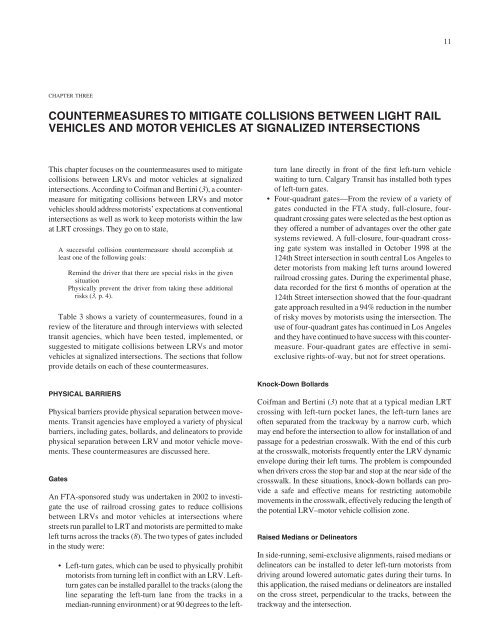Light Rail Vehicle Collisions with Vehicles at Signalized Intersections
Light Rail Vehicle Collisions with Vehicles at Signalized Intersections
Light Rail Vehicle Collisions with Vehicles at Signalized Intersections
- No tags were found...
Create successful ePaper yourself
Turn your PDF publications into a flip-book with our unique Google optimized e-Paper software.
11CHAPTER THREECOUNTERMEASURES TO MITIGATE COLLISIONS BETWEEN LIGHT RAILVEHICLES AND MOTOR VEHICLES AT SIGNALIZED INTERSECTIONSThis chapter focuses on the countermeasures used to mitig<strong>at</strong>ecollisions between LRVs and motor vehicles <strong>at</strong> signalizedintersections. According to Coifman and Bertini (3), a countermeasurefor mitig<strong>at</strong>ing collisions between LRVs and motorvehicles should address motorists’ expect<strong>at</strong>ions <strong>at</strong> conventionalintersections as well as work to keep motorists <strong>with</strong>in the law<strong>at</strong> LRT crossings. They go on to st<strong>at</strong>e,A successful collision countermeasure should accomplish <strong>at</strong>least one of the following goals:Remind the driver th<strong>at</strong> there are special risks in the givensitu<strong>at</strong>ionPhysically prevent the driver from taking these additionalrisks (3, p. 4).Table 3 shows a variety of countermeasures, found in areview of the liter<strong>at</strong>ure and through interviews <strong>with</strong> selectedtransit agencies, which have been tested, implemented, orsuggested to mitig<strong>at</strong>e collisions between LRVs and motorvehicles <strong>at</strong> signalized intersections. The sections th<strong>at</strong> followprovide details on each of these countermeasures.PHYSICAL BARRIERSPhysical barriers provide physical separ<strong>at</strong>ion between movements.Transit agencies have employed a variety of physicalbarriers, including g<strong>at</strong>es, bollards, and deline<strong>at</strong>ors to providephysical separ<strong>at</strong>ion between LRV and motor vehicle movements.These countermeasures are discussed here.G<strong>at</strong>esAn FTA-sponsored study was undertaken in 2002 to investig<strong>at</strong>ethe use of railroad crossing g<strong>at</strong>es to reduce collisionsbetween LRVs and motor vehicles <strong>at</strong> intersections wherestreets run parallel to LRT and motorists are permitted to makeleft turns across the tracks (8). The two types of g<strong>at</strong>es includedin the study were:• Left-turn g<strong>at</strong>es, which can be used to physically prohibitmotorists from turning left in conflict <strong>with</strong> an LRV. Leftturng<strong>at</strong>es can be installed parallel to the tracks (along theline separ<strong>at</strong>ing the left-turn lane from the tracks in amedian-running environment) or <strong>at</strong> 90 degrees to the leftturnlane directly in front of the first left-turn vehiclewaiting to turn. Calgary Transit has installed both typesof left-turn g<strong>at</strong>es.• Four-quadrant g<strong>at</strong>es—From the review of a variety ofg<strong>at</strong>es conducted in the FTA study, full-closure, fourquadrantcrossing g<strong>at</strong>es were selected as the best option asthey offered a number of advantages over the other g<strong>at</strong>esystems reviewed. A full-closure, four-quadrant crossingg<strong>at</strong>e system was installed in October 1998 <strong>at</strong> the124th Street intersection in south central Los Angeles todeter motorists from making left turns around loweredrailroad crossing g<strong>at</strong>es. During the experimental phase,d<strong>at</strong>a recorded for the first 6 months of oper<strong>at</strong>ion <strong>at</strong> the124th Street intersection showed th<strong>at</strong> the four-quadrantg<strong>at</strong>e approach resulted in a 94% reduction in the numberof risky moves by motorists using the intersection. Theuse of four-quadrant g<strong>at</strong>es has continued in Los Angelesand they have continued to have success <strong>with</strong> this countermeasure.Four-quadrant g<strong>at</strong>es are effective in semiexclusiverights-of-way, but not for street oper<strong>at</strong>ions.Knock-Down BollardsCoifman and Bertini (3) note th<strong>at</strong> <strong>at</strong> a typical median LRTcrossing <strong>with</strong> left-turn pocket lanes, the left-turn lanes areoften separ<strong>at</strong>ed from the trackway by a narrow curb, whichmay end before the intersection to allow for install<strong>at</strong>ion of andpassage for a pedestrian crosswalk. With the end of this curb<strong>at</strong> the crosswalk, motorists frequently enter the LRV dynamicenvelope during their left turns. The problem is compoundedwhen drivers cross the stop bar and stop <strong>at</strong> the near side of thecrosswalk. In these situ<strong>at</strong>ions, knock-down bollards can providea safe and effective means for restricting automobilemovements in the crosswalk, effectively reducing the length ofthe potential LRV–motor vehicle collision zone.Raised Medians or Deline<strong>at</strong>orsIn side-running, semi-exclusive alignments, raised medians ordeline<strong>at</strong>ors can be installed to deter left-turn motorists fromdriving around lowered autom<strong>at</strong>ic g<strong>at</strong>es during their turns. Inthis applic<strong>at</strong>ion, the raised medians or deline<strong>at</strong>ors are installedon the cross street, perpendicular to the tracks, between thetrackway and the intersection.












